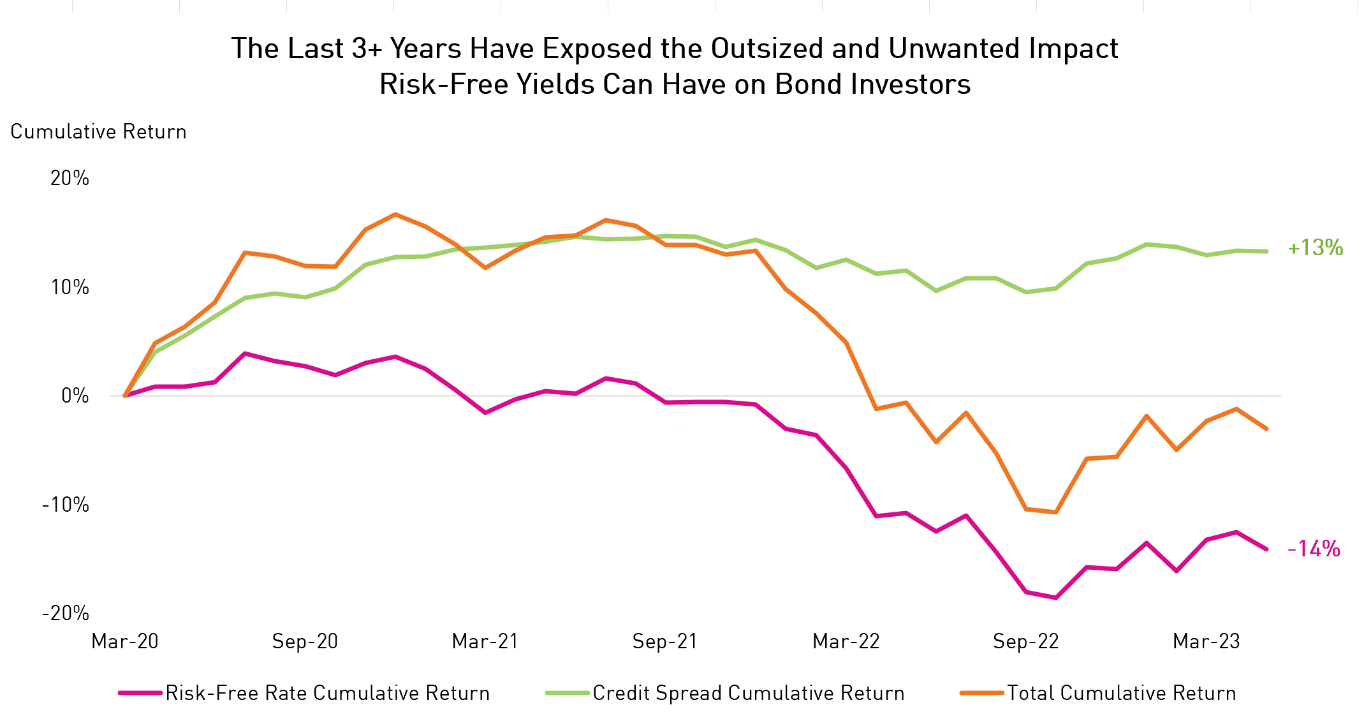For advisors seeking diversification from traditional long-only bond exposure, private markets aren't the only choice

The “back to bonds” narrative is going strong. Wealth advisors have been gravitating back to this beaten-up asset class over the past year, locking in decade-high yields for clients and positioning for a rally should interest rates begin to retreat.
However, the turbulence experienced in 2022 exposed the limitations of traditional fixed income strategies and taught investors an agonizing lesson. To create consistent, resilient, “all-weather” bond portfolios, advisors must adopt a more creative strategy when investing in fixed income moving forward.
Despite popular belief, this doesn’t mean advisors should simply add private market exposure as these strategies can impose liquidity and transparency constraints. Instead, they should also utilize alternative fixed income (AFI) strategies, which can be more liquid and robust. Understandably, during the TINA (“there is no alternative”) decade, when equities reigned supreme, there was less need to devote attention to bonds, let alone alternative strategies.
But things are different now. It is more timely than ever for advisors to rethink their approach and consider AFI strategies and the value they can bring to clients’ portfolios.
Alternative Fixed Income 101
When considering adding any asset to a portfolio, we first examine what investment objectives the asset may help achieve. Both traditional and alternative fixed-income strategies share similar goals: capital preservation, a stable income stream, and diversification.
The critical difference, however, lies in how these goals are achieved.
Essentially, a traditional fixed-income strategy takes long-only positions in a portfolio of bonds, aiming to generate regular income from coupons, garnering short-term capital gains if yields fall.
AFI strategies also hold long positions, but then incorporate a combination of short selling, leverage, and targeted risk management techniques to create a different set of return drivers.
For instance, an AFI strategy may hedge out interest rate risk and significantly lower a bond’s price sensitivity to interest rate changes while capturing above-market gains from credit risk exposure and market volatility.
The manager can mix and match different long-short pairs; for example, going long a bond and shorting another with a similar interest rate risk profile, and seizing capital gains from the outperformance of either position. This is just one example of the many types of relative value trades that AFI strategies can execute to generate positive returns without being hostage to top-down market dynamics.
Consistent returns, irrespective of rate fluctuations
Today, many speculate that we are entering a falling rate scenario. However, heavy reliance on interest rate movements may come at the price of increased volatility and can create higher reinvestment risk for advisors when putting their clients’ capital back to work.
By managing duration risk, AFI strategies address these concerns and can provide consistent returns at greater yields to maturity compared to traditional strategies, regardless of interest rate fluctuations. Medium- and long-term investors can achieve better full-cycle returns using AFI strategies while diversifying their rate exposure and seeing less reinvestment risk over a longer horizon.
AFI has outperformed and minimized drawdowns in periods when traditional fixed income is tied to the movement of broader markets. Prime examples are 2021 and 2022, when both bonds and stocks retreated in tandem amid rising rates. The ability to hedge out interest rate risk allowed many AFI strategies to provide positive returns instead of the deeply negative returns that most traditional approaches saw.

For illustrative purposes only. Source: Bloomberg. Data as of May 31st, 2023.
Cumulative Return calculated using monthly returns during the period ranging from 04/2020 to 05/2023. Risk-Free Rate Cumulative Return = cumulative return of the Duration-Neutral Treasury component of the Bloomberg Global Aggregate Corporate Bond Index. Credit Spread Cumulative Return = cumulative monthly return of the monthly Excess Returns component of the Bloomberg Global Aggregate Corporate Bond Index.
AFI: What fixed income should have been
Through true diversification and consistent returns, AFI strategies offer what fixed income as an asset class has tried to do for so long.
By highlighting the strengths of AFI, wealth advisors can introduce their clients to an all-weather solution that fortifies their portfolios against volatility and helps them achieve their financial goals.
Consider the case of retirees or clients approaching retirement. These individuals prioritize wealth preservation and require stable cash flows to support their lifestyle. By incorporating AFI into their portfolios, these clients can secure a reliable source of income that helps them maintain financial independence throughout their golden years.
Similarly, ultra-high-net-worth individuals with more sophisticated portfolios can benefit from further diversification beyond traditional asset classes. AFI can complement the client’s private investments, adding an extra layer of diversification to reduce overall volatility while delivering consistent absolute returns.
How to select the right AFI strategy for clients
Various AFI strategies are available in the marketplace, each catering to different client profiles. They differ in terms of geographical diversification, credit quality, liquidity, and tactics — such as being yield-focused versus active trading. Public AFI strategies offer better liquidity and transparency compared to private alternatives and are particularly attractive options.
Given the breadth and complexity of AFI, wealth advisors need access to the right resources and expertise to identify strategies suitable for their clients. To make informed decisions regarding strategy selection, advisors can utilize their dealer’s managed solutions experts who are specialized in alternatives.
For DIY researchers, one should first look for reputable AFI managers with a proven track record, an experienced management team, and a robust investment process. Next, evaluate the risk-return profile of the strategy and consider factors such as liquidity to ensure it aligns with the client's objectives and constraints. The Alternative Investment Management Association (AIMA) is a good resource hub to read more about the usefulness and limitations of alternatives as an investment solution.
As the investment paradigm evolves, so should the way wealth advisors approach fixed income. The inclusion of Alternative Fixed Income strategies presents a transformative opportunity to unlock potential for clients, reaping the benefits of the asset class in any rate environment.
Imran Dhanani, Principal & Director, National Accounts & Product Strategy at RPIA, is responsible for product strategy and managing relationships with key partners in the retail distribution channel. Imran also serves as an internal and external resource for the Client Portfolio Management team, providing colleagues with market commentary and analysis on portfolio construction and product fit.



